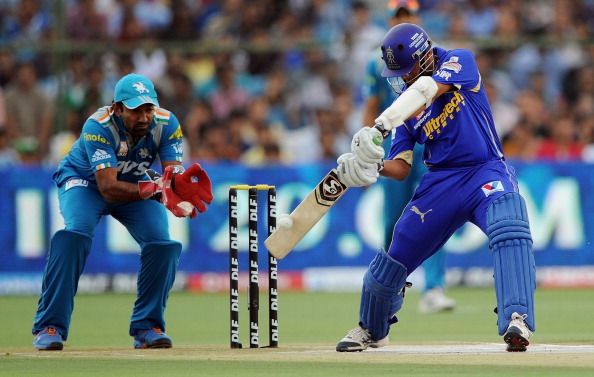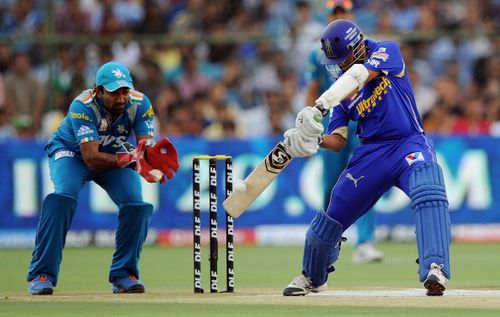
Is the Dravid and Rahane pair the best opening combination of this year's IPL?

Sunil Gavaskar made a good point when he was speaking in the “Extraaaa innings” a couple of weeks back about the way the term “aggression” is being misunderstood in cricket. He said that “aggression”, according to many, is about whacking the cricket balls for the maximum all the time. During the post match analysis of a match involving Rajasthan Royals and Delhi Daredevils, the former Mumbai batsman was all praise for the way the century opening stand was brought about by Rahul Dravid and Ajinkya Rahane. He said that aggression was just not about raining in sixes all the time, playing extravagant shots, but on the other hand, even boundaries scored along the ground by adopting proper cricketing shots should be treated the same as well.
That’s precisely what we have seen from the willows of both Dravid and Rahane whenever they have opened together in IPL till yesterday’s “Qualifier 2”. In fact, whenever Royals were left to chase big totals, particularly during the second half of the tournament, it was the opening stand of these two classy players, which came in handy for the team. As the adage goes – “Well begun is half done”. By the time one of them left the scene after getting out, they had made it easy for the batsmen that follow to chase down the total, making use of the long handle efficiently with wickets in hand. Perhaps they would have given themselves a chance even yesterday in their knock-out match against Mumbai Indians, had they opted to bat second as these two openers have always done well during chasing.
That said, it does not mean they were not successful while batting first. In fact, during the initial stages of the tournament, they had done pretty well as openers in setting the target too. There is no doubt that Chris Gayle has been the most successful and dangerous opener in T20s, but even he has succumbed to pressure while chasing targets. The kind of flow which we have seen from him while setting the targets was found to be absent most of the time whenever his team was batting second. Fully aware of the risk involved in his style of play, the Jamaican always preferred to play himself in before exploding. Given the style of their play, both Dravid and Rahane have no such inhibitions. Rahane, at least, may fall to a false shot, just like he did yesterday attempting to sweep Harbhajan Singh and getting bowled around his legs. But his senior partner has been very careful in not gifting away his wickets. Either way, they both have proved that they are the best opening pair of this year’s IPL.
Leave alone IPL, world cricket has been a witness to so many different opening combinations in all forms of the game till date. Compared to all the other combinations, the one between Dravid and Rahane, seen in this year’s IPL, stands very much unique. The Rajasthan openers have been very solid in technique and have played only proper cricketing shots to find the fence, more often than not. That way, they have looked as a rare breed of opening pair ever since the shorter versions of the game were introduced.
At the advent of limited overs internationals – also called as ODI cricket – the urgency to enhance the scoring rate was not felt initially, at least for more than a decade or so. But only when the rule of field restrictions was introduced in 1992, the need to keep the scoreboard ticking was increasingly felt. It was then that different teams tried experimenting with various opening combinations, the first of which was started by the then Kiwi captain Martin Crowe, who used Mark Greatbatch as a pinch-hitter at the top of the order alongside Rod Lathem. While the Southpaw used his muscle power to disturb the bowlers’ rhythm, his partner was comparatively subdued, but he also had his own way of smacking the loose deliveries. This was one of the most successful opening pairs during those days.
From thereon, all teams started ensuring that they deployed at least one big hitter at the top of the order. In fact, there were some teams which had both their openers as big hitters. Most of the successful teams were operating with this policy in order to exploit the field restrictions. But no team has ever thought of chalking out a strategy which could give their most technically equipped players a chance to have a go at the top of the order. Even during the 80s, when field restrictions were not the part of ODI rules, every team had an aggressive opener batting for it. For India, Gavaskar had a partner in Srikkanth, who used to thrash the bowlers on all sides of the park. Similarly for West Indies, Desmond Haynes had an able partner in Gordon Greenidge, who used to operate with punishment of bowlers, primarily in his mind.
When such was the urgency and aggression which was in place decades back, it is really a welcoming sight to see an IPL T20 team of the modern era trying to operate with two classical batsmen at the top of the order. The best part is that they have been doing it quite successfully too. The beauty of this opening pair was not only they have built a partnership at more than a run a ball rate but also they seemed to have done it risk free. Whenever one of them got out, the other was able to do a sheet anchor role for his team, leaving the batsmen that follow to throw caution to the winds. One can never imagine either Gilchrist or Gayle performing an anchor role for his team, can we?
Whether it was Jayasuriya and Kaluwitharana or Andy Flower and Alistair Campbell, to name a few, every one of those combinations used to switch over to the attacking mode right from the start, pummelling the bowlers over the boundary lines all across the park. The aerial shots were prevalent even with the combination of Tendulkar – Ganguly, though the former was more technically equipped as a player than most of the cricketers. So, it is really a fascinating sight to see a team working out entirely a different type of combination and making it successful.
Dravid might have played his last IPL match yesterday but his stint with Rahane in this year’s IPL can just prove to be a trendsetter, inciting other teams to resort to trying classical batting at the top of the order, even in international 50 overs format. And why not – both these players have mustered more than 400 runs for their franchise, most of which were accumulated as openers.